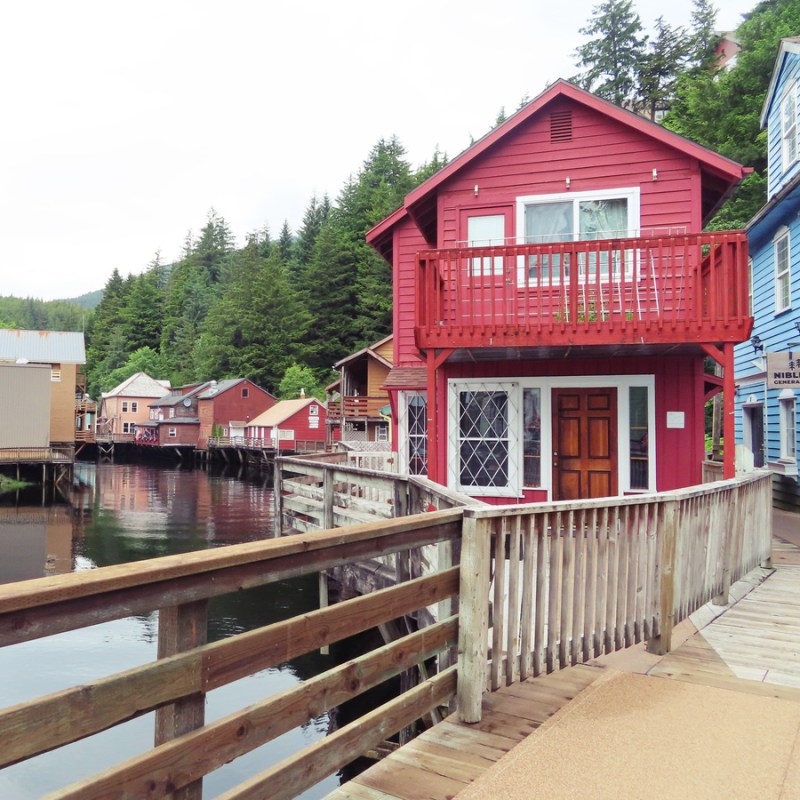
Ketchikan, Alaska, located at the southernmost entrance to the famed Inside Passage, is the beginning of the final frontier. Situated on Revillagigedo Island, Ketchikan is the gateway to the Inside Passage, a system of waterways for ships and boats that weave through the islands and their stunning wilderness views.
Videos by TravelAwaits
The abundant fishing and timber resources drew non-Natives to the area. The main economic activities still include fishing, tourism, and timber. During summer months, the massive cruise ships dwarf the downtown as nearly 10,000 tourists depart the ships to spend their day shopping and dining in Ketchikan.
In addition to being known for its salmon, magnificent scenery, and Native culture, Ketchikan has a rich past that involves the booze and brothels that were a historical part of the growth of this city. During a visit to Ketchikan, I was able to walk Creek Street to see the former brothels and learn about the women who worked there — and how they were an integral part of the growth of the city. I toured the dive bars that run through the city and learned many facts — along with a few tall tales — about this historic city and its origins.

1. It’s Named As Alaska’s First City (But Not Because It Was First)
Ketchikan, known as the first city of Alaska, isn’t called that because it was the first area settled upon, but rather because it’s the southernmost city and the first place you arrive to when traveling north to Alaska. It’s also the first port on northbound Alaska cruises.
Incorporated in 1900 (with a population of 800), Ketchikan was named after the Ketchikan Creek that streams through town.
2. Small Town, Large City
Although the city of Ketchikan covers only 5.90 square miles, it is one of the largest cities in Alaska with one of the highest populations — a little over 8,000 residents.

3. The Oldest Bar In Ketchikan Fell Into The Creek, And Stories Abound
As stories sometimes do, the tales about the time the Arctic Bar fell into the creek and washed into the Thomas Basin grow taller with time. During my visit, someone mentioned in passing that the bar had fallen into the water. Tales of a man sleeping in a bed upstairs going with the building into the water, as well as those of people learning to dive so they could collect the cases of beer and bottles of liquor at the bottom, abound. How much is true depends on whom you ask.
We do know that on December 11, 1962, Ketchikan Daily News reported that during a period of heavy rainfall, trees and debris swept down Ketchikan Creek, crashing into the piling underneath the two-story frame building. The weakened structure then fell and “spilled its entire contents, including cases of liquor and beer” into the “angry, rain-swollen water.”
The news story says that the upstairs occupants and patrons in the bar escaped. A later update said that divers recovered the bar’s 6,200-pound safe — containing jewelry and important papers — from the bottom of the waters and that the papers were wet but still readable.
Whether all the tales are true or not, it makes for an interesting night of drinking when you ask locals about what happened. Visit the Arctic Bar at its new location to read news stories laminated on the bar top and hear the stories firsthand.

4. At One Time, Ketchikan Was Home To Perhaps The Greatest Concentration Of Dive Bars In America
Apparently, during the town’s logging heyday during the ’70s and ’80s, there were 56 bars in this small town. While there aren’t as many these days, you’ll still find a bar on nearly every corner or across the way. Many are considered dive bars — that special type of drinking hole that has local flavors of drink and customers, plus live music, billiards or darts, and plenty of shots and beers on tap. Most serve Alaskan beer and liquors in a boisterous atmosphere.

At the Arctic Bar, the location has mascots of two “happy” bears throughout, a rowdy and endearing co-owner behind the bar, plus a ship’s bell that hangs at the corner of the bar. Don’t ring it, though — unless you’re prepared to buy the bar a round.
Some additional dive bars we visited during our trip included the Sourdough Cocktail Bar, Totem Bar, Bawden Street Brewing Co., and the Heen Kahidi Lounge at Cape Fox Lodge. While we didn’t make it to Hole in the Wall, located outside of town a few miles, one bartender told us it’s the bar that most represents Ketchikan because it’s where the locals go to get away from town.

5. It’s The Salmon Capital Of The World
Ketchikan is proud of its fishing culture and boasts a welcome sign stating it’s the Salmon Capital of the World. Its waters are home to five different species of salmon. Whether you’re there to take a guided sport fishing tour, fish for salmon in Ketchikan Creek, or want to taste the variety of seafood at the restaurants, you’ll get your fill of fresh-caught, wild Alaskan seafood in Ketchikan.
For more places to sample great seafood, check out the seven best places to savor seafood in Ketchikan.
6. The Weather Isn’t What You Would Expect
In Ketchikan (and other parts of Alaska), rain is called liquid sunshine. Because Ketchikan is surrounded by the Tongass rainforest, it rains often and unexpectedly. In fact, it frequently rains even when it’s sunny and warm. So don’t be surprised by rain — even on sunny days.
Still, most days are cloud covered, and it’s the fourth wettest place in the world with more than 160 inches of rain annually — raining 300 days of the year.
Ketchikan winters run warmer than one might expect in Alaska, averaging from the 30s- to the mid-40s, with summers on the cooler side, usually with 50- to 60-degree temperatures. It makes for mild temperatures year-round, but be sure and pack layers no matter what time of year you visit.
7. Many Residents Are Of Tlingit, Haida, Or Tsimshian Descent
The Tlingit people were seafarers who were skilled fishers, traders, and hunter-gatherers, the northernmost of the Northwest Coast Indians of North America, located in southern Alaska and British Columbia and Yukon in Canada. Ketchikan was named after the Tlingit word for creek, Kitschk-hin. Currently, 19 percent of Ketchikan’s residents are of Tlingit, Haida, and/or Tsimshian descent.

8. The Largest Collection Of Old Totem Poles Lives Here
The totem poles in Ketchikan tell the history of its people through sculptures carved on wooden poles or posts. There are Tlingit, Haida, and Tsimshian totem poles throughout town. To see even more, visit Totem Bight State Historical Park, an open-air park with a clan house, totem poles, recreated tribal homes, and an antique car and firearms museum; the Totem Heritage Center, a downtown museum that houses precious 19th-century totem poles that were collected and preserved with permission from the Alaska Native elders; and Saxman Totem Park, located just a couple miles outside of Ketchikan, which is home to 25 totems that are authentic replicas of original poles that were left in abandoned villages as Native Alaskans moved into more populated cities.

9. Creek Street And The Brothels
I first noticed the sign at the top of the hill near Cape Fox Lodge: Married Man’s Trail. When asked about the unique name for a trail, we were told that men would sneak along this trail through the woods to reach the brothels on Creek Street below undetected. The creek was lined with as many as 30 brothels between 1903 and 1953. It was Ketchikan’s red light district.
While prostitution was profitable in many towns along the Inside Passage, starting in 1900, Ketchikan had an advantage in that northbound vessels were required to stop in the “first city.”

Shawna Lee, in addition to owning a local tour company, is the director of Port Operations at Ward Cove Dock Group. While talking about the brothels, she explained the importance of the brothels as well as the women’s impact on building the community: “The red light district, of course, was at the turn of the century, and there were all the men who were coming up for the gold rush, but if they didn’t have enough money to complete their journey and go up to Skagway, they ended up here. Ketchikan became this burgeoning town for fishing, of course, and logging and, [and] lots of men. So, you know … there was a demand. And there are all these real pioneer women that actually began opening these businesses.”
Lee went on to explain that the women associated with the brothels, “funded things in town, like paid for school and paid for books for kids. There were amazing women who ran the Creek Street brothels. They don’t get enough credit, I think, for what they contributed to the community.”
While the men were working in the fishing grounds or at the logging camps, the pioneer women were running the bars, restaurants, and brothels in town, which Lee says, “is really what supports the whole infrastructure of the town. Alaska has a lot of great pioneer women’s stories.”
Today, the historic district is lined with brightly colored houses hoisted on pillars above the creek. A wooden plank boardwalk takes you to see the previous brothels that are filled with artsy shops and placards telling about the brothels.
Travel Tip: While in town, be sure to catch the Lumberjack Show, during which lumberjacks show their strength and agility while throwing axes, climbing 50-foot trees, or rolling on logs on the water.

